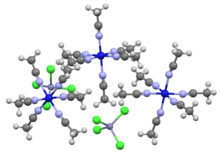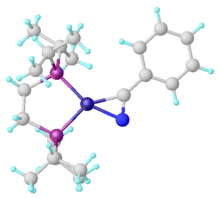Transition metal nitrile complexes
Transition metal nitrile complexes are coordination compounds containing nitrile ligands. Because nitriles are weakly basic, the nitrile ligands in these complexes are often labile.[1]
copper(I)_hexafluorophosphate.png)
Scope of nitriles
Typical nitrile ligands are acetonitrile, propionitrile, and benzonitrile. The structures of [Ru(NH3)5(NCPh)]n+ have been determined for the 2+ and 3+ oxidation states. Upon oxidation the Ru-NH3 distances contract and the Ru-NCPh distances elongate, consistent with amines serving as pure-sigma donor ligands and nitriles functioning as pi-acceptors.[2]
.png)
Synthesis and reactions
Acetonitrile, propionitrile, and benzonitrileare also popular solvents, which is usually the medium for the synthesis of their complexes. Because nitrile solvents have high dielectric constants, cationic complexes containing a nitrile ligand are often soluble in a solution of that nitrile.
Some complexes can be prepared by dissolving an anhydrous metal salt in the nitrile. In other cases, a suspension of the metal is oxidized with a solution of NOBF4 in the nitrile:[3]
- Ni + 6 MeCN + 2 NOBF4 → [Ni(MeCN)6](BF4)2 + 2 NO
Heteroleptic complexes of molybdenum and tungsten can by synthesized from their respective hexacarbonyl complexes. [4]
- M(CO)6 + 4 MeCN + 2 NOBF4 → [M(NO)2(MeCN)4](BF4)2

Reactions
Transition metal nitrile complexes are usually employed because the nitrile ligand is labile and relatively chemically inert. Cationic nitrile complexes are however susceptible to nucleophilic attack at carbon. Consequently some nitrile complexes catalyze the hydrolysis of nitriles to give the amides.
Fe- and Co-nitrile complexes are intermediates in nitrile hydratase enzymes. N-coordination activates the sp-hybridized carbon center toward attack by nucleophiles, including water. Thus coordination sets into motion the catalytic hydration:
- M-NCR + H2O → M-O=C(NH2)R
- M-O=C(NH2)R + NCR → O=C(NH2)R + M-NCR
Examples
Many homoleptic nitrile complexes are isolated as salts with weakly coordinating anions.
- Tetrakis(acetonitrile)copper(I) hexafluorophosphate ([Cu(MeCN)4]PF6), a colorless solid that serves as a source of naked "Cu+"
- Bis(benzonitrile)palladium dichloride (PdCl2(PhCN)2), an orange solid that serves as a source of "PdCl2"
- Hexakis(acetonitrile)nickel(II) tetrafluoroborate ([Ni(MeCN)6](BF4)2), a blue solid that is a source of naked "Ni2+"
- Dimolybdenum deca- and octa-kis(acetonitrile) tetrafluoroborate ([Mo2(MeCN)8/10](BF4)4), a source of "naked" Mo24+. Related Tc24+, Re24+, and Rh24+ complexes are also known.
- Tricarbonyltris(propionitrile)molybdenum(0) (Mo(CO)3(C2H5CN)3), a source of "Mo(CO)3". Related Cr and W complexes are known.[6]
Complexes of η2-nitrile ligands
In some of its complexes, nitriles function as η2-ligands. This bonding mode is more common for complexes of low-valence metals, such as Ni(0). Complexes of η2-nitriles are expected to form as transient intermediates in certain metal-catalyzed reactions of nitriles, such as the Hoesch reaction and the hydrogenation of nitriles. In some cases, η2-nitrile ligands are intermediates that preceded oxidative addition.[7]

See also
- Cyanometalate - coordination compounds containing cyanide ligands (coordinating via C)
References
- Rach, S. F.; Kühn, F. E. (2009). "Nitrile Ligated Transition Metal Complexes with Weakly Coordinating Counteranions and Their Catalytic Applications". Chemical Reviews. 109 (5): 2061–2080. doi:10.1021/cr800270h. PMID 19326858.CS1 maint: uses authors parameter (link)
- Shin, Yeung-gyo K.; Szalda, David J.; Brunschwig, Bruce S.; Creutz, Carol; Sutin, Norman (1997). "Electronic and Molecular Structures of Pentaammineruthenium Pyridine and Benzonitrile Complexes as a Function of Oxidation State". Inorganic Chemistry. 36 (14): 3190–3197. doi:10.1021/ic9700967. PMID 11669976.
- Heintz, Robert A.; Smith, Jennifer A.; Szalay, Paul S.; Weisgerber, Amy; Dunbar, Kim R. (2002). "Homoleptic Transition Metal Acetonitrile Cations with Tetrafluoroborate or Trifluoromethanesulfonate Anions". Inorg. Synth. 33: 75–83. doi:10.1002/0471224502.ch2.
- Thomas, Richard R.; Sen, Ayusman (2007). "Acetonitrile Complexes of Selected Transition Metal Cations". Inorg. Synth. 28: 63–67. doi:10.1002/9780470132593.ch14.
- I. Sotofte; R. G. Hazell; S. E. Rasmussen (1976). "Hexaacetonitrilenickel(II) Tetrachlorozincate. A Crystal Structure with Serious Overlap in the Patterson Function". Acta Crystallographica Section B. 32 (6): 1692–1696. doi:10.1107/S0567740876006249.
- Kubas, Gregory J.; van der Sluys, Lori Stepan (1990). "Tricarbonyltris(Nitrile) Complexes of Cr, Mo, and W". Inorg. Synth. 28: 29–33. doi:10.1002/9780470132593.ch6.
- Churchill, D.; Shin, J. H.; Hascall, T.; Hahn, J. M.; Bridgewater, B. M.; Parkin, G. (1999). "The Ansa Effect in Permethylmolybdenocene Chemistry: A [Me2Si] Ansa Bridge Promotes Intermolecular C−H and C−C Bond Activation". Organometallics. 18: 2403–2406. doi:10.1021/om990195n.
- García, J. J.; Arévalo, A.; Brunkan, N. M.; Jones, W. D. (2004). "Cleavage of Carbon−Carbon Bonds in Alkyl Cyanides Using Nickel(0)". Organometallics. 23 (16): 3997–4002. doi:10.1021/om049700t.CS1 maint: uses authors parameter (link)